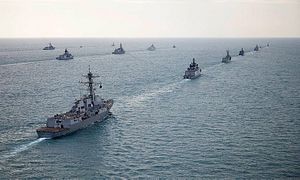Kakadu 2018, Australia’s largest air and naval exercise, concludes this week and marks the first time that China’s PLA Navy has participated. The Kakadu series of exercises is held every other year in the seas north of Darwin in Australia’s Northern Territory. The exercise began on August 30th and concludes on September 15th.
Twenty-seven countries participated this year, bringing 23 ships and submarines, 21 aircraft, and over 3,000 personnel. The PLA Navy, who were observers at the 2016 exercise, participated fully for the first time, represented by the PLA Navy frigate Huangshan. The United States Navy sent the destroyer USS Michael Murphy and a P-8A maritime patrol aircraft.
The Huangshan is a Type 054A frigate is a multi-mission platform that carries anti-ship missiles and medium-range air defense missiles, and is optimized for anti-submarine operations with an embarked helicopter and a variety of anti-submarine weapons.
China’s participation comes after the United States conspicuously disinvited China from this year’s Rim of the Pacific (RIMPAC) Exercise as a consequence for its deployment of anti-ship missiles to the bases it has built on disputed features in the South China Sea’s Spratly Islands and other coercive activities in the region.
When China participated in previous RIMPAC exercises in 2014 and 2016, it did not take part in combat drills or weapons events, instead focusing on search and rescue, submarine rescue, and humanitarian assistance events. A former adviser to the Chief of Naval Operations explained to USNI News that China’s presence at the exercise had always presented an intelligence-gathering risk because the United States does conduct high-end combat training with some of its closest allies and partners.
In an emailed statement ahead of this year’s Kakadu exercise, Australia’s Defence Ministry told Reuters that “There are no plans for China to participate in live-fire activities,” and that China would similarly participate in events like passage exercises, ship-to-ship communication, replenishments, and maneuvering.
After the exercise kicked off with ships from Australia, Singapore, and China conducting close maneuvers and sailing in formations using international codes, it appears that the PLA Navy did end up participating in some combat-related events.
Official photos posted from the exercise show the Huangshan conducting a gunnery drill with its 76-milimeter main gun. Collin Koh, a Research Fellow at the S. Rajaratnam School of International Studies in Singapore, also noted that the Huangshan conducted an anti-submarine drill with the HMAS Newcastle, an Australian frigate, according to the Mandarin edition of the PLA Daily. The drill appeared to involve the two ships coordinating their helicopters to home-in on a simulated submarine.
Australia and China have a complex security relationship. The Defence Ministry statement to Reuters on China’s participation in Kakadu 2018 said that the two countries had built a productive defense relationship that facilitated transparency and builds trust. In April, three Australian warships had an encounter with the PLA Navy though the Australian government denied that they were challenged. Australia has publicly supported the United States’ Freedom of Navigation Operations in the South China Sea that challenge China’s excessive territorial and jurisdictional claims politically but has not conducted any of its own, though the United States has said that it would welcome similar Australian operations.

































